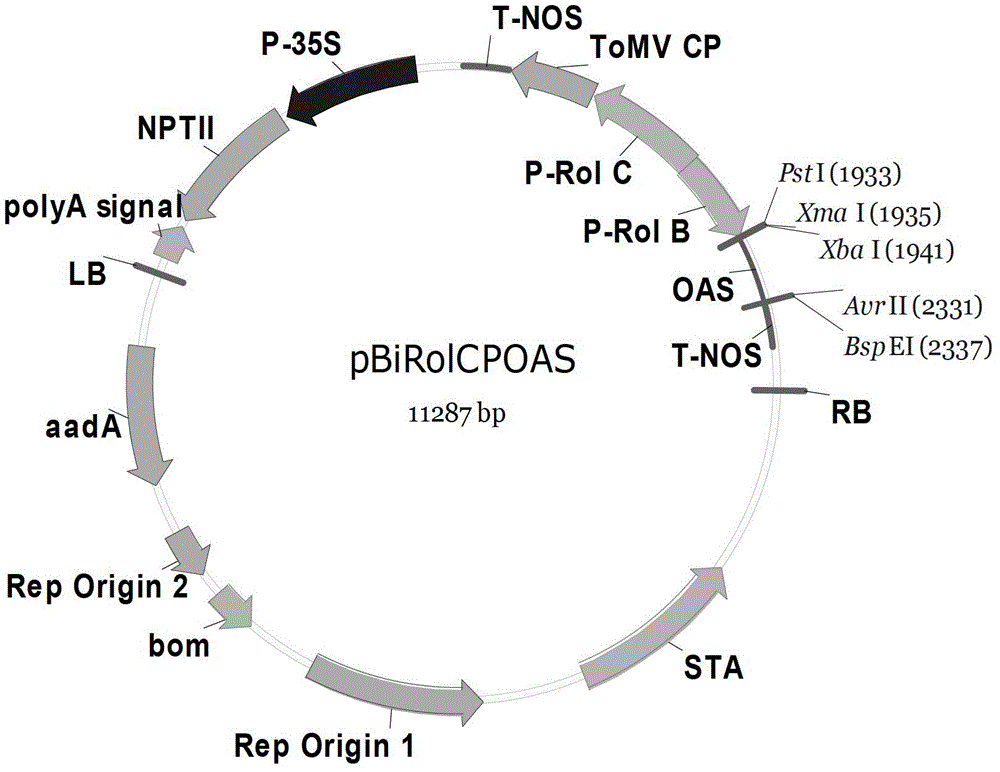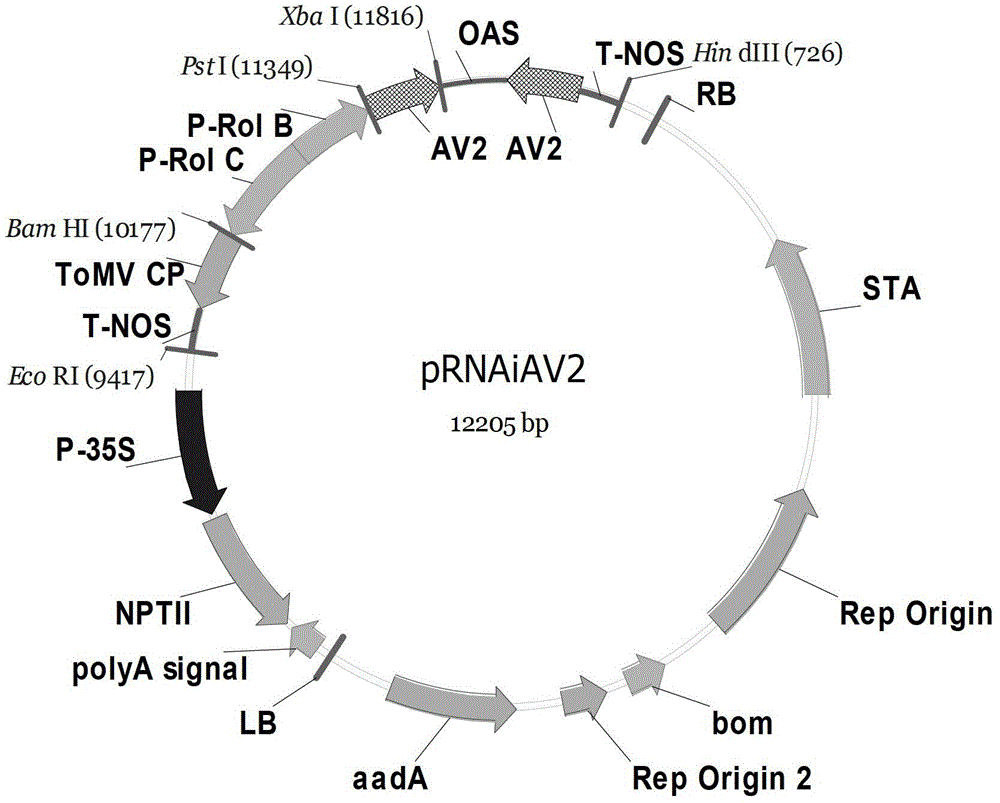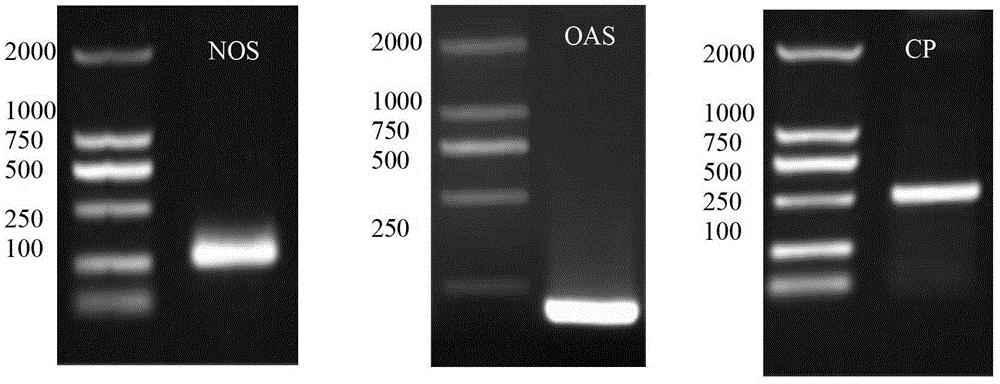Plant expression vector, aphid gene dsrna expression vector and application thereof
A technology of plant expression vectors and vectors, applied in the field of genetic constructs, can solve problems such as the increase in the number of beneficial insects in the field
- Summary
- Abstract
- Description
- Claims
- Application Information
AI Technical Summary
Problems solved by technology
Method used
Image
Examples
Embodiment 1
[0018] Example 1: Preparation of DNA fragments required for vector construction
[0019] carrier ( figure 1 ) DNA fragments such as ToMV CP, ToMV OAS and NOS terminator required for the construction were all obtained by PCR, and the restriction sites required for cloning at both ends were introduced by PCR primers, and the primers used were as follows:
[0020]
[0021] For the amplification of ToMV OAS and ToMV CP, the genomic RNA of ToMV was used as a template, and the primer pairs OAS_F / OAS_R and CP_F / CP_R were used for RT-PCR, respectively. RT-PCR using III One-Step RT-PCR Systemwith (Cat. No. 12574018, Invitrogen) Reagents were completed according to the instructions.
[0022] Amplification of the NOS terminator was carried out by PCR with primers NOS_F / NOS_F using pBI221 as a template. PCR products were separated by agarose gel electrophoresis. The size of the amplification product of the NOS terminator is 272bp, the size of the amplification product of ToMV OA...
Embodiment 2
[0024] Embodiment 2: pBiRolCPOAS vector construction
[0025] The digestion products in the following processes were separated by agarose gel electrophoresis, purified with QIAquick GelExtraction Kit, and DNA fragments were ligated with T4 DNA ligase (promega, catalog number M1801) according to the instructions.
[0026] The construction process of RNAi vector is as follows:
[0027] 1. Cloning the ToMV CP in Example 1 into pBi221 through the restriction endonuclease BamHI / SacI site, and constructing it as a vector p221CP;
[0028] 2. Cut the Rol promoter from the pUC57 vector with BamHI / PstI double enzyme digestion ( Figure 4 ), separated by agarose gel electrophoresis, and recovered, cloned into the BamHI / PstI site of p221CP, and constructed as the vector p221-Rol-CP;
[0029] 3. Cloning the NOS terminator in Example 1 into p221-Rol-CP through the restriction endonuclease HindIII / PstI site, and constructing the vector p221-RolCPNOS;
[0030] 4. Cloning the ToMV OAS in Ex...
Embodiment 3
[0032] Embodiment 3: pRNAiAV2 vector construction
[0033] This example is a method for constructing a dsRNA expression vector of the cotton aphid V-type proton pump gene (AV2) using the vector pBiRolCPOAS.
[0034] The AV2 gene fragment of cotton aphid was amplified from the cDNA of cotton aphid by designing degenerate primers based on the homologous gene sequence (XM_001950855) of green peach aphid. The amplified fragment was cloned into the pGEM-T easy vector (promega), and the sequence determined by sequencing was SEQID NO:1.
[0035] The pRNAiAV2 vector construction process is as follows:
[0036] 1. Use primers AV2_F (CCCGGGTTCATACAGTAAATATACAA) and AV2_R (TCTAGATATAACTGATCAAAGTCAGCACGG) to amplify a partial fragment of AV2, and introduce XmaI and XbaI sites at both ends of the fragment; clone the amplified fragment into the pGEM-T easy vector (promega) for sequencing;
[0037] 2. Use XmaI and XbaI to cut out the AV2 fragment from the T vector in 1., and name it AV2_XX...
PUM
 Login to View More
Login to View More Abstract
Description
Claims
Application Information
 Login to View More
Login to View More - R&D
- Intellectual Property
- Life Sciences
- Materials
- Tech Scout
- Unparalleled Data Quality
- Higher Quality Content
- 60% Fewer Hallucinations
Browse by: Latest US Patents, China's latest patents, Technical Efficacy Thesaurus, Application Domain, Technology Topic, Popular Technical Reports.
© 2025 PatSnap. All rights reserved.Legal|Privacy policy|Modern Slavery Act Transparency Statement|Sitemap|About US| Contact US: help@patsnap.com



